|
|
The Dukes of Grafton: The Racing
 |
|
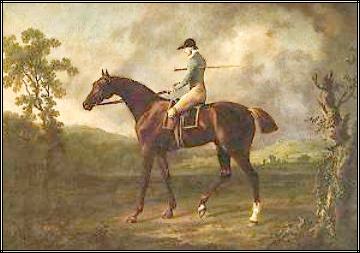 | | The 1758 chestnut colt ANTINOUS (Blank-Sister to Spinster (the Widdrington Mare) by Old Partner), bred by the 3rd Duke of Grafton, was favored in a 1764 500 guineas match against the Duke of Cumberland's subsequently famous Herod, but lost; reputedly £100,000 was riding in bets on this race. Antinous lost again to Herod the following year in a return match, but won a number of important races and matches, including the Great Subscription Purse at York, both before and after meeting Herod. At the age of 9 he was retired to the Grafton stud. Herod's success was not lost on the Duke; he later purchased the Pot-8-Os son,Waxy, out of a Herod mare, for his stud, and bred the Julia daughter Promise to Herod's best son, Highflyer, producing Prunella. He then repeatedly mated Waxy with Prunella and her daughter, Penelope, to produce as astounding number of important matrons and Classic winners. Antinous and Jockey, 1764, by George Stubbs; background possibly by George Barrett. |
The Dukes and their Horses
Charles, the 2nd Duke of Grafton(1683-1757), in addition to being an able courtier who served an unprecedented thirty-three year term as Lord Chamberlain to two kings (and adroitly balancing two mistresses simultaneously--one the wife of the Earl of Burlington and the other Princess Amelia, the daughter of George II!), was an enthusiastic sportsman, to such an extent that George II, himself a keen sportsman, in a moment of pique, told the Duke it was "a pretty occupation" for a man of quality and of his age to hunt a poor fox [Grafton was 52 at the time].* His hounds were lodged at Croydon, and foxes were captured in Whittlebury Forest and transported via hamper to Croydon to provide sport. The Grafton pack was established around 1715 at Wakefield, and toward the end of the season the hounds were transported to Euston to continue the chase; the 3rd and 4th Dukes continued this latter practice. His enthusiastic support of the construction of Westminster Bridge in 1748 is said to have been due to his annoyance at having to transport horses and hounds across the Thames in barges when loaned some hunting country on the south side of the river, or, alternatively, his impatience at having to wait for a ferry when going from London to Croydon to hunt. He finally quit the field after a fall from his horse at the age of 72.
The racing stud at Euston was founded by his grandson, the 3rd Duke, whose lifespan encompassed the transition from races and matches run by four year olds or older in heats over four miles, until one horse won two outright, to the form of racing more or less recognized today, with a single race for three-year-olds forming the basis of what have come to be known as the "classics." The horses of the 3rd Duke and his son won the Derby or the Oaks 25 times between 1800 and 1837; the 4th Duke's horses won the 2,000 Guineas five times, and the 1,000 Guineas every year between 1819 and 1827, but one (1824).
|
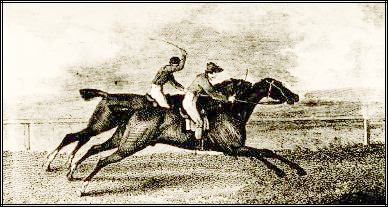 | | The Duke of Grafton's POPE (later Waxy Pope and in Ireland, Lord Sligo's Waxy, or Waxy Pope), 1806 bay colt by Waxy out of Grafton's famous matron Prunella, edging out Wizard (Sorcerer - mare by Precipitate) in the 1809 Derby, Tom Goodison on Pope and the famous Frank Buckle on Wizard. Pope went on to win a sweep of 200 gs. at Ascot and for 250 gs. at Newmarket (a day after the latter winning yet another sweep at Newmarket for 450 gs.). He also won the Garden Stakes at Newmarket and several Newmarket races the following spring. Waxy Pope was leading sire in Ireland nine times, and had a huge influence on the development of the thoroughbred there. His son *Skylark (1826) and grandson *Langford (1833) were imported into America; Saucebox and Thad Stevens were among their descendants. Engraving by John Scott after F. Sartorius. |
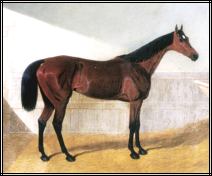
| |
Grafton bred and owned Oaks winner Oxygen, an 1828 bay filly, by Emilius and out of Whizgig (1819, by Rubens), a daughter of Penelope. She was a speedy filly who ran for four years, her Oaks win considered a "very fine race, and a truly run one," with 21 starters. She ran second in the Newmarket St. Leger to Camarine, and the following year won the Oatlands, beating the good colt Mazeppa. She was granddam in tail-female descent of stallions St. Germain and Trumpeter.
|
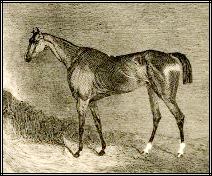
| |
Turquoise was a brown Grafton-bred and raced filly by Selim, and out of Pope Joan, one of Prunella's best daughters. Ridden by John Day, she came from well behind in the Oaks to take that classic by two lengths, and she won several other races that year at Newmarket. As a four-year-old she won several races, one consisting of 2-1/2 mile heats, and at age five she ran once in the spring at Newmarket, failing to win, after which she was retired to the Grafton stud. Her dam, Pope Joan, produced two other classic winners -- Tontine, winner of the 1,000 Guineas in 1825, and Turcoman, winner of the 2,000 Guineas in 1827. Pope Joan's offspring all had names starting with "T."
|
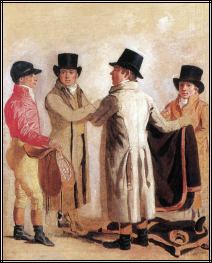
| |
Left to right: famous jockey Frank Buckle, Grafton stable manager John Wastell, and trainer Robert Robson, with a stable lad. The painting, by Benjamin Marshall (c. 1802) probably commemorates Wastell's win of the Oaks with his own filly, Scotia, in 1802.
|
|
|
The Racing
The 3rd Duke enthusiastically embraced racing from an early age, and his horses were reasonably successful in matches and races throughout the latter half of the eighteenth century. While at that time racing was intended to amuse the nobility, anyone could watch the races, and gambling losses among both the rich and the poor became so widespread that statutes were enacted to limit the amount of money an owner could bet on his own horse, in an attempt to limit deception and chicanery amongst owners, jockeys and professional gamblers. These laws were largely honored in the breach. The Grafton Dukes, however, were always noted for their sportsmanship; Nimrod referred to the 3rd Duke as one of "...the few great winners amongst great men."
While moderately successful with his eighteenth century runners, it wasn't until after the turn of the century that the Grafton racing successes came to the fore. The 1758 success of Antinous (see above) was followed by the short-lived career of the five year old Leonatus who placed third in a £50 plate two-mile run in 1770, after four heats; two days later he was started again for another £50 plate in four mile heats, and had to run five of these heats against the (later) Duke of Queensbery's Sportsman, who won. After that race Leonatus was retired to stud.
In 1802, Tyrant, a colt the 3rd Duke bred from Sea Fowl, a Dam of the Two True Blues tail-female mare (family 3), by Pot-8-Os, won Grafton his first Derby, more than twenty years after it was established. Nimroddescribed Tyrant as "one of the worst horses that ever won a Derby," and his win was credited to the excellent riding of champion jockey Frank Buckle. His later sucesss at stud was limited.
However, this was the beginning of a long, successful campaign of the classics from the Grafton breeding program. The 3rd Duke saw the first decade of success based on the foundations laid by his breeding program just after the turn of the century. His son, George, the 4th Duke, continued the racing and breeding successes forward to the 1830s. Between them, the two Dukes won approximately £250,000 in public stakes in the years their horses ran, largely between 1800 and 1831.
The team assembled to support the Grafton efforts included John Wastell, who managed their stables at Newmarket and trainer Robert Robson. The Graftons employed a number of jockeys--Frank Buckle, Dick Goodison, William Clift and John Day among them. When Wastell died, his duties were assumed by the 4th Duke's half-brother, Rev. Lord Henry Fitzroy. After Henry Fitzroy's death in 1823 and Robson's retirement in 1828, the Grafton racing stables gradually ceased to send out winners, and by the 1840s few were left in the racing stud. The 5th Duke of Grafton had no interest in racing, and the dynasty established by the two Dukes was carried on by others, breeding the descendants of their famous mares and horses.
John Wastell
Born in Yorkshire in 1736, and educated at Cambridge, which is where he became friends with Grafton, Wastell, who was a member of the Jockey Club, managed the Duke's horses, keeping meticulous trial books for the Duke, and also bred and owned his own horses, his 1802 Oaks winner Scotia probably his most successful horse. He died eight months after his old friend, the 3rd Duke died, in 1811.
Robert Robson
Robson was born to horses, his father had trained Highflyer for Lord Bolingbroke, and as a private trainer for Sir Frederick Poole at Lewes, he trained Waxy to his 1793 win of the Derby and his subsequent successes, including the Jockey Club Plate at Newmarket and the King's Plate at Salisbury in 1794, and the King's Plate at Guildford and Salisbury in 1796 (Waxy broke down in his 1797 run for the Gold Cup). Waxy was subsequently purchased by the Duke of Grafton, and was the progenitor of a large number of successful racing horses and broodmares for Grafton.
|
A successful and respected trainer at Newmarket, Robson is generally credited with raising the status of trainer from glorified groom to professional. Robson resisted the desire to run 2 year olds, one of the offshoots of the establishment of the three-year-old classics. He also dispensed with training horses in blankets and rugs, partially due to the shortened distances of races--in theory horses sweated more with rugs doing slower work and thus did not need as many fast and long distance workouts--but also because he had, it was said a reputation for "delicate handling" of his equine charges. Because of his successes, his influence in these matters spread to other stables; he was known as "The Emperor of Trainers." He trained four Derby winners for the Graftons--Tyrant, Pope, Whalebone, and Whisker--and Azor (1817) and Emilius (1823) for other owners. He also trained the 2,000 Guineas and 1,000 Guineas winners for the 4th Duke--all 13 of them between 1819 and 1827. Robson retired from training in 1828.
Rev. Lord Henry Fitzroy
Born in 1770, Henry Fitzroy was the half-brother of the 4th Duke, from his father's second productive wife. When John Wastell, who successfully managed the 3rd Duke's stables at Newmarket, died a few months after the 3rd Duke, The Reverend Lord Henry, "a fine specimen of the sporting parson," managed the stables for a very productive dozen years for his brother, until his death in 1823.
|
Grafton Classic Winners (Bred and Raced)
 | |  | |  | | | Left to Right: Frank Buckle, Dick Goodison, John Day, Snr. |
| |
The Jockeys
Frank Buckle, 1766-1832, is racing's most famous jockey, with nine Oaks victories and twenty-seven Classic wins; he rode his first race at seventeen, and his last at the age of 65. He rode for a number of owners, principally Lord Grosvenor, Sir Charles Bunbury and Colonel Mellish, but he rode and won a fair amount for the Grafton stable, including his third Derby win on Tyrant, and his ninth (1823) Oaks win on Zinc.
William Clift was known for his sharp tongue and his physical endurance; at the age of seventy he would walk the twenty-eight miles from Newmarket to Bury St. Edmunds and back for exercise. Clift rode the Dukes' first two Oaks winners, Pelisse (1804) and Morel (1808), and rode Whalebone to his 1810 Derby win.
Dick Goodison, who rode the Duke of Grafton's Pope to his 1809 Derby win, was known for carrying £500 in notes around with him always, having found himself short once when a good betting opportunity presented itself. He also was known as a safe rider and a good judge of pace. He rode Barefoot to his 1823 St Leger win, among other successes.
In 1826 the 4th Duke chose an unproven young jockey, John Day, to ride Dervise (Merlin - Pawn Junior by Waxy) in the 2,000 Guineas, and Problem (Merlin - Pawn by Trumpator) in the 1,000 Guineas, both of which he won, and in doing so, started on the road to success. He continued to ride Grafton horses through the 1830s; after winning the Oaks in 1831 with Oxygen, Grafton said to Day, "John Day, you're a thief." "My Lord," cried out the astonished jockey, "what have I done to displease you?" "What have you done," answered the Duke, still looking stern, "you stole that race!"** Day was known as a "good rough jockey," but not in the same class with the best. He later turned to breeding and training, and two of his sons followed him as jockeys.
* Falk, The Royal Fitz Roys,p. 97.
**Falk, Ibid.p. 233.
|
|

